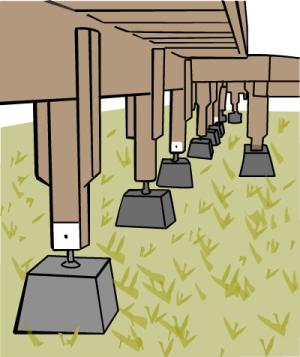
Different styles of footings will provide different levels of protection from moisture and termites.
The footings for your deck or pergola will serve as the cornerstones of your support structure. Improper footings will make for an unstable frame, which can cause the wood to bow and warp and potentially cause harm to someone using it at the wrong time. Especially where reactive soil is a concern, you should consult with your local council on what sort of footings will be required to safely support your deck or pergola.
What types of footings are available?
- Concrete-embedded posts –This is the most common means of supporting a structure, a simple hole filled with concrete around a post to keep it straight and steady. For most backyards, this will be sufficient support. If you're using wood, make sure the posts have been treated for insects and the timber is rated for use in-ground. Be sure that the post has sufficient drainage to allow water to escape too. Steel posts have fewer issues, but moisture seepage can still be a problem, so your posts should use at least hot-dip galvanised steel to protect against corrosion.
- Stirrup posts – These posts are capped on the exposed end with a horseshoe like squared stirrup into which your posts can be bolted. These can be a good idea if water seepage will be a problem into the wood, as any damage will be visible and detectable, allowing you to do something about it early.
Advertisement
- High wind post supports – These supports are long, squared loops of steel with a bracket on one end into which the post is bolted. The main body of the loop is concreted in. These supports can be a great choice where corrosion from seepage might be a problem as there is no hollow space running through the centre. They also provide great support for decks which might be higher up or on a slope, or pergolas with unusually tall frames.
- Brick piers – Brick can be a great choice for a support structure as it is not at all vulnerable to insects and will never rot. Brick piers sit on a concrete footing which may or may not have a steel rod running through for additional support. They can be attached to the bearers directly, or be the base on which to bolt in steel posts. Their weight and mass offer great support in reactive soils.
